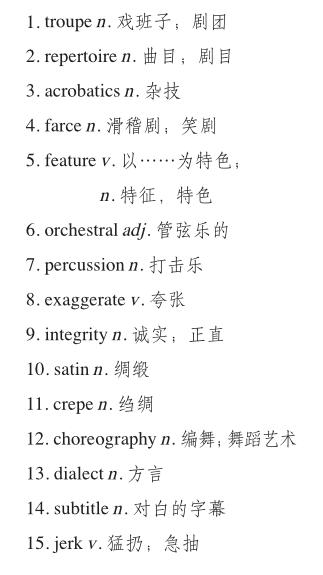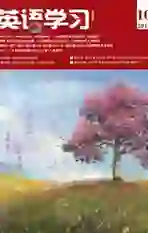Peking/Beijing Opera京剧
2019-11-14

编者按:在发展素质教育、全面落实立德树人根本任务的今天,英语教育工作者要有意识地引导学生用英语讲述中国故事,传播中华优秀文化,为实现“培养具有中国情怀、国际视野和跨文化沟通能力的社会主义建设者和接班人”的英语课程目标而努力。《英语学习》将连载程晓堂教授、张祖春研究员共同主编、湖北教育出版社出版的《学英语讲中国故事》的选篇,旨在丰富教师教学材料的同时,表达和传播中华优秀文化,培养学生的中国情怀。
本篇选自《学英语 讲中国故事——传统艺术篇》。中国传统艺术具有几千年的积累,是中华民族的艺术瑰宝,也是全人类的宝贵财富。中国传统艺术以其浓郁的乡土气息、淳厚的艺术内涵和生动的历史痕迹,越来越受到世界人民的喜爱和欣赏。京剧被列入“世界非物质文化遗产代表作名录”,是传播中国传统艺术文化的重要媒介之一。阅读此篇后,您一定会感受到京剧艺术的博大精深和无限魅力。
There are more than 360 regional branches of traditional opera in China. Known as the national opera of China, Peking Opera is the most influential and representative of all the traditional operas in China.
History
Although it is called Peking Opera, it didnt originate in Beijing but in the provinces of Anhui and Hubei. It is believed that Peking Opera came into being after 1790 when the four most famous opera troupes1 from Anhui Province paid a visit to Beijing. Based upon traditional Anhui Opera, Peking Opera has also adopted repertoire2, music and performing techniques from Kun Opera (昆曲) and Qinqiang Opera (秦腔) as well as traditional folk tunes. It took in the best from each opera and eventually formed its own highly stylized music and performing techniques.
Features
Peking Opera is a combination of music, dance, art, acrobatics3, and martial arts. With its beautiful paintings, delicate costumes, and graceful gestures, Peking Opera has developed into a comprehensive art system.
With many elements of Chinese culture, Peking Opera presents the audience with an encyclopedia of Chinese culture. Its repertoire includes historical plays, comedies, tragedies and farces4.
Music
Peking Opera features5 an orchestral6 and percussion7 band. The orchestral band frequently accompanies peaceful scenes while the percussion band provides the right atmosphere for battle scenes. The band usually sits on the left side of the stage. It works together with the actors by adding the right mood to the action on the stage.
Characters
Traditionally, women in China were forbidden to enter theatres, so all Peking Opera characters were played by men. But now, women enjoy equal rights with men on the stage, and more women are appearing on the Opera stage than ever before.
Characters in Peking Opera are basically divided into four types of roles: sheng (生the positive male role), dan(旦the positive female role), jing (凈the face-painted male role), and chou(丑 the clown or the negative character). They are further classified by age and profession. Every type of role has its own facial makeup and costume, so that the audience can easily figure out the identity of the character the moment it appears on the stage.
Facial Makeup
The facial makeup of Peking Opera highlights and exaggerates8 the principal features of the characters. One major characteristic of Peking Opera is the colors painted on the face of a character. It is vital to the understanding of a play. This is a feature unique to Chinese operas.
Makeup helps to transform actors into characters. Face paints are widely used. Red symbolizes uprightness and loyalty, white represents evil or cunning, and black stands for honesty and integrity9. In Peking Opera, the jing is a face-painted male role. The chou is a male clown, whose bridge of nose and eyes are marked with white powder.
Costumes
Peking Opera costumes are called xingtou (行頭) which are made from silk, satin10 and crepe11. Costumes of the actors and actresses represent the rank of the characters. Red is the main color for high rank characters. The characters of virtue also wear red. Lower ranking officials wear blue, etc. Beautiful decorations such as flowing sleeves and wings attached on the helmet or hats give value to detailed choreography12 in Peking Opera.
Performance Skills
The main performing skills of Peking Opera are singing, reciting, acting and martial arts (唱、念、做、打) . The operatic dialogues and monologues are recited in Beijing dialect13, and some of the words are pronounced in a special manner. That is why every Peking Opera performance is accompanied with subtitles14 in Chinese and English. Performers, in addition to singing, use well-established movements, such as smoothing a beard, adjusting a hat, jerking15 a sleeve, or raising a foot, to express certain emotions and meaning. Opening a door, walking at night, rowing a boat, eating, drinking, etc., are all demonstrated by stylized movements of the actors and actresses. Performers also use their eyes and facial expressions to convey specific meanings.
Notes

